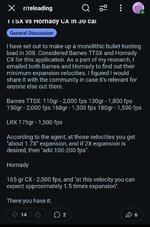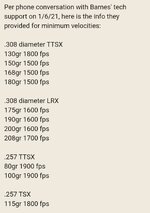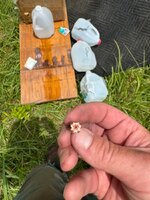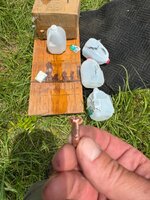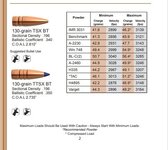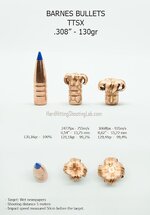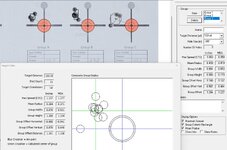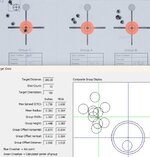BringBackThe80s
FNG
- Joined
- Sep 5, 2023
- Messages
- 47
Any reason that, when choosing between monolithics for my all-game/all-ethical-distances load in my 308 Winchester, I should disqualify Barnes 175 gn LRX?
Yes, I know that's a bit heavy for a monolithic in 308. I spent a good bit of time chasing a consistently accurate loading for the 130TTSX, but twice after a couple range sessions thinking I've settled on a MOA-or-better-for-5+shots recipe, it has made a scattered group at 2" or more. No Bueno. Next, a pressure ladder with 150TTSX did not look amazing. A pressure ladder with 168TTSX looked a bit better--but 168TTSX does not offer a significant speed advantage over the 175 LRX, and i already had 100 of the 175s on hand.
When I shot a pressure ladder with the 175 LRX, the last 7 shots, each increasing by 0.3 grains, made a ragged hole/cluster under 1". An initial OCW test shows promise, I think. And soon archery season will put reloading on the back burner, so I'd like to go ahead and nail down a recipe with the 175 LRX so I can spend subsequent range trips practicing at varying distances.
Everybody says to shoot monolithics light and fast for caliber. I understand the reasons and would do so if I had landed on a light-for-caliber load before midsummer. But by 400 yds the 175 will be moving about as fast as the lighter, "faster" bullets. At 500 yds, it will still be carrying 1300 ft lbs (enough even for elk, I think), and moving at 1800+ fps (reportedly more than enough for full expansion). Drop with 175 is more than with lighter options, but I've got a laser and cheat sheet for that. And wind drift is notable less with the 175.
My thinking: Out to 175 yards, I've had 100% great results on deer using 250 gn, .451" Barnes at only ~2300fps MV. For that matter, I've killed dozens of deer with arrows moving a tenth that speed. It seems to me that a 175gn .308 LRX shot at 2600fps MV to bisect deer or elk vitals should punch through bone, expand, and kill cleanly out to 500 yards.
But, if I'm mistaken or need to choose a different monolithic, I'd like to change up before I get any closer to deer season.
Thoughts?
Yes, I know that's a bit heavy for a monolithic in 308. I spent a good bit of time chasing a consistently accurate loading for the 130TTSX, but twice after a couple range sessions thinking I've settled on a MOA-or-better-for-5+shots recipe, it has made a scattered group at 2" or more. No Bueno. Next, a pressure ladder with 150TTSX did not look amazing. A pressure ladder with 168TTSX looked a bit better--but 168TTSX does not offer a significant speed advantage over the 175 LRX, and i already had 100 of the 175s on hand.
When I shot a pressure ladder with the 175 LRX, the last 7 shots, each increasing by 0.3 grains, made a ragged hole/cluster under 1". An initial OCW test shows promise, I think. And soon archery season will put reloading on the back burner, so I'd like to go ahead and nail down a recipe with the 175 LRX so I can spend subsequent range trips practicing at varying distances.
Everybody says to shoot monolithics light and fast for caliber. I understand the reasons and would do so if I had landed on a light-for-caliber load before midsummer. But by 400 yds the 175 will be moving about as fast as the lighter, "faster" bullets. At 500 yds, it will still be carrying 1300 ft lbs (enough even for elk, I think), and moving at 1800+ fps (reportedly more than enough for full expansion). Drop with 175 is more than with lighter options, but I've got a laser and cheat sheet for that. And wind drift is notable less with the 175.
My thinking: Out to 175 yards, I've had 100% great results on deer using 250 gn, .451" Barnes at only ~2300fps MV. For that matter, I've killed dozens of deer with arrows moving a tenth that speed. It seems to me that a 175gn .308 LRX shot at 2600fps MV to bisect deer or elk vitals should punch through bone, expand, and kill cleanly out to 500 yards.
But, if I'm mistaken or need to choose a different monolithic, I'd like to change up before I get any closer to deer season.
Thoughts?

